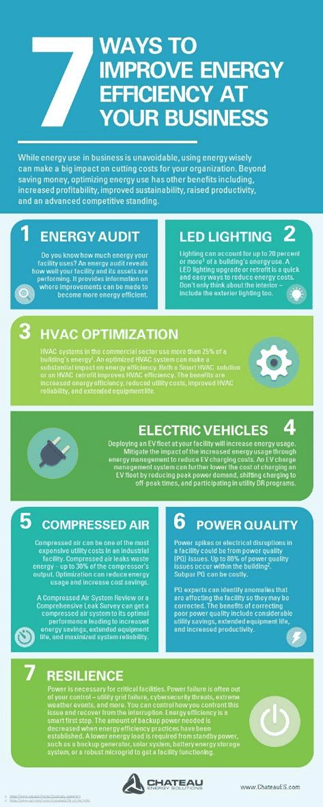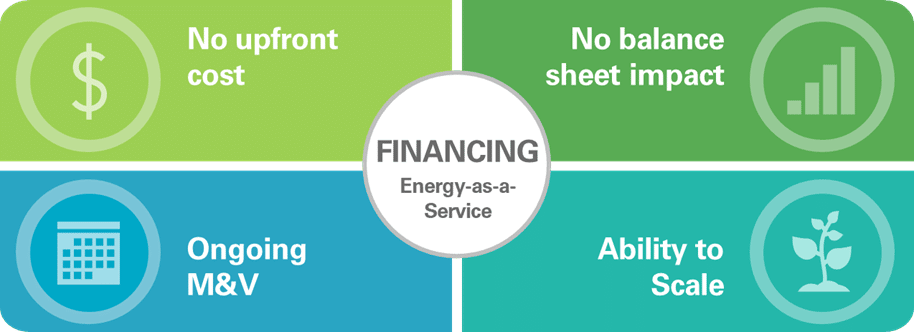
 Posted by Pam Hoddinott
Posted by Pam Hoddinott October is Energy Awareness Month. It’s a month focused on encouraging individuals and organizations to understand better how they use energy and how to manage this use better. On average, 30% of the energy used in commercial buildings is wasted, according to the EPA1. Did you know that the biggest use of electricity in a commercial building are lighting and HVAC, totaling nearly 50%2?
While energy use in business is unavoidable, using this energy wisely can make a big impact on cutting costs for your organization. Beyond saving money, optimizing energy use has other benefits including, increased profitability, improved sustainability, raised productivity, and an advanced competitive standing.
So, if you are asking yourself, “How can I improve energy efficiency at my company?” Here are a few things to consider:
1. Energy Audit. Do you know how much energy your facility uses? A building energy audit is one of the best ways to understand how your facility uses energy. These energy assessments will uncover underlying energy efficiencies. An energy audit, also called a building audit, reveals how well your facility and its assets are performing. It will also provide information on where improvements can be made to become more efficient moving forward.
A skilled engineering professional will perform this audit to evaluate energy performance and consumption by conducting a thorough walk-through of the facility. In addition to the physical walk through, the engineer will also examine expense histories and utility bills. There are a variety of energy audits, but consider an ASHRAE Level 1, 2, or 3 audit as they are widely used and have established standardized industry practices and reporting.
2. LED Lighting. Have you upgraded or retrofitted your facility with LED lighting? Lighting can account for a large amount of a building’s electricity use — up to 20 percent or more2. A LED lighting upgrade or LED retrofit is one of the quickest and easiest ways to optimize operations and reduce energy costs at a facility. When considering upgrading lighting to LED, don’t just think about the interior lighting, but include the exterior lighting as well.
When looking for a lighting expert, find a company that can provide turnkey lighting services – including lighting audit, design and layout, installation, controls, rebate management, warranty administration, and financing options. Installing LED lighting is a win-win – improve lighting quality and reduce energy costs.
3. HVAC. How efficient is your HVAC system? HVAC systems in the commercial sector use more than 25% of a building’s energy2. An optimized HVAC system can make a substantial impact on energy efficiency. Depending on the type of HVAC equipment and the nature of the performance issues, the route to an energy-efficient HVAC is not always the same.
Smart HVAC solutions combine technology with energy-saving measures. While an HVAC retrofit includes the installation of new components into the existing system which then improves HVAC efficiency. The result of either an implemented Smart HVAC solution or an HVAC retrofit provides the same benefits of increased energy efficiency, reduced utility costs, improved HVAC reliability, and extended equipment life. An optimized HVAC system will also benefit the occupants in the facility by providing a more comfortable environment.

4. Electric Vehicles. Currently, transportation accounts for less than 1% of U.S. electricity use2. This percentage is expected to grow as EVs become more common. Do you have a plan on how to implement EV Chargers at your facility? Do you know how to mitigate the impact of this increased energy usage on your organization?
Energy management of an electric vehicle fleet will help reduce EV charging costs. Additionally, an EV charge management system can further lower the cost of charging your electric vehicle fleet by reducing peak power demand, shifting charging to off-peak times, and participating in utility demand response (DR) programs. To help make the transition a smooth one, look for a well-qualified partner in both EV fleet charging AND energy management.

5. Compressed Air. Does your facility use compressed air? Compressed air can be one of the most expensive utility costs in an industrial facility. Compressed air leaks account for a sizeable source of wasted energy, up to 30% of the compressor’s output. Compressed Air Optimization provides an opportunity for significant energy reduction and cost savings.
There are a couple of different ways to make sure your compressed air system is performing at its optimal level – a Compressed Air System Review or a Comprehensive Leak Survey. Both will get you on the path to an optimized compressed air system leading to increased energy savings, extended life of equipment, and maximized system reliability.
6. Power Quality. If your facility has power spikes or electrical disruptions, the issue could be with power quality. Up to 80% of power quality issues occur behind the meter3 – that means within the building itself.
Subpar power quality can impact the success of your organization – for example, interrupted production time, which can be costly. Experts in the power quality field will collect data and identify pattern anomalies that are affecting the facility. The benefits of correcting poor power quality are numerous and include considerable utility savings, extended equipment life, and increased productivity.

7. Resilience. Power is a necessity for critical facilities such as hospitals, data centers, and industrial plants. Power failure can come from a variety of causes out of your control – utility grid failure, cybersecurity threats, extreme weather events, and more. What you can control is how you confront this issue and recover from the interruption. Energy efficiency is a smart first step as part of a resiliency plan.
If energy efficiency practices are already in place, it will decrease the amount of backup power needed. This means a lower energy load is required from your standby power, such as a backup generator, solar system, battery energy storage system, or a more robust microgrid to get your facility functioning. Find an energy partner that understands energy optimization as well as Distributed Energy Resources (DER) and microgrids.
As you can see, there are numerous ways your organization can become more aware of its energy usage and find ways to save energy and support a more sustainable future. Understanding your organization’s energy use is valuable. Taking action to save on energy costs is vital.
If you are considering implementing any of these energy saving measures, don’t forget that financing is available. Many times, energy efficiency upgrades can pay for themselves. Financing these optimization projects without any up-front costs is an ideal way to implement energy efficient solutions and improve the operation of your facility.

While Energy Awareness Month is only one month out of the year, it is important that energy efficiency is practiced every day of the year. Look for an experienced team that has success driving operational efficiency in businesses. Find a partner that can provide insightful analysis of your energy use and actionable items customized for your organization. Remember, there may be several different big and small ways optimization can be reached.
Chateau Energy Solutions’ credentialed team of energy experts have been designing and implementing customized energy programs for years. Let’s talk about how we can gain an understanding of your energy use and ultimately help you cut the cost of your organization’s utility bill.
Chateau Energy Solutions Making Energy an Asset®
Ready to get started on the path to energy efficiency and sustainability?